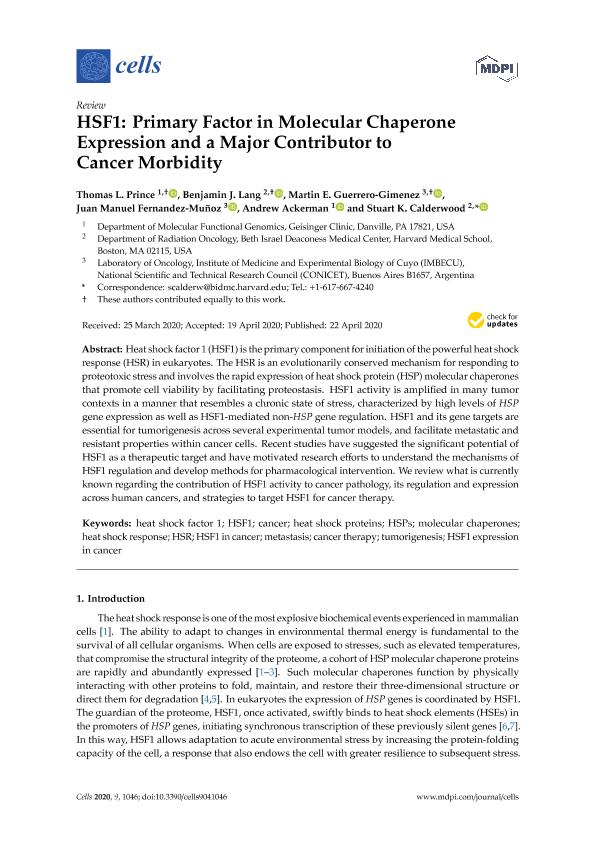Mostrar el registro sencillo del ítem
dc.contributor.author
Prince, Thomas L.
dc.contributor.author
Lang, Benjamin J.
dc.contributor.author
Guerrero Gimenez, Martin Eduardo

dc.contributor.author
Fernandez Muñoz, Juan Manuel

dc.contributor.author
Ackerman, Andrew
dc.contributor.author
Calderwood, Stuart K.
dc.date.available
2021-02-26T15:41:58Z
dc.date.issued
2020-04
dc.identifier.citation
Prince, Thomas L.; Lang, Benjamin J.; Guerrero Gimenez, Martin Eduardo; Fernandez Muñoz, Juan Manuel; Ackerman, Andrew; et al.; HSF1: Primary Factor in Molecular Chaperone Expression and a Major Contributor to Cancer Morbidity; MDPI; Cells; 9; 4; 4-2020; 1-27
dc.identifier.uri
http://hdl.handle.net/11336/126784
dc.description.abstract
Heat shock factor 1 (HSF1) is the primary component for initiation of the powerful heat shock response (HSR) in eukaryotes. The HSR is an evolutionarily conserved mechanism for responding to proteotoxic stress and involves the rapid expression of heat shock protein (HSP) molecular chaperones that promote cell viability by facilitating proteostasis. HSF1 activity is amplified in many tumor contexts in a manner that resembles a chronic state of stress, characterized by high levels of HSP gene expression as well as HSF1-mediated non-HSP gene regulation. HSF1 and its gene targets are essential for tumorigenesis across several experimental tumor models, and facilitate metastatic and resistant properties within cancer cells. Recent studies have suggested the significant potential of HSF1 as a therapeutic target and have motivated research efforts to understand the mechanisms of HSF1 regulation and develop methods for pharmacological intervention. We review what is currently known regarding the contribution of HSF1 activity to cancer pathology, its regulation and expression across human cancers, and strategies to target HSF1 for cancer therapy.
dc.format
application/pdf
dc.language.iso
eng
dc.publisher
MDPI
dc.rights
info:eu-repo/semantics/openAccess
dc.rights.uri
https://creativecommons.org/licenses/by-nc-sa/2.5/ar/
dc.subject
CANCER
dc.subject
CANCER THERAPY
dc.subject
HEAT SHOCK FACTOR 1
dc.subject
HEAT SHOCK PROTEINS
dc.subject
HEAT SHOCK RESPONSE
dc.subject
HSF1
dc.subject
HSF1 EXPRESSION IN CANCER
dc.subject
HSF1 IN CANCER
dc.subject
HSPS
dc.subject
HSR
dc.subject
METASTASIS
dc.subject
MOLECULAR CHAPERONES
dc.subject
TUMORIGENESIS
dc.subject.classification
Bioquímica y Biología Molecular

dc.subject.classification
Ciencias Biológicas

dc.subject.classification
CIENCIAS NATURALES Y EXACTAS

dc.title
HSF1: Primary Factor in Molecular Chaperone Expression and a Major Contributor to Cancer Morbidity
dc.type
info:eu-repo/semantics/article
dc.type
info:ar-repo/semantics/artículo
dc.type
info:eu-repo/semantics/publishedVersion
dc.date.updated
2020-08-04T19:37:03Z
dc.identifier.eissn
2073-4409
dc.journal.volume
9
dc.journal.number
4
dc.journal.pagination
1-27
dc.journal.pais
Suiza

dc.description.fil
Fil: Prince, Thomas L.. Geisinger Clinic. Department of Molecular Functional Genomics; Estados Unidos
dc.description.fil
Fil: Lang, Benjamin J.. Harvard Medical School; Estados Unidos
dc.description.fil
Fil: Guerrero Gimenez, Martin Eduardo. Consejo Nacional de Investigaciones Científicas y Técnicas. Centro Científico Tecnológico Conicet - Mendoza. Instituto de Medicina y Biología Experimental de Cuyo; Argentina
dc.description.fil
Fil: Fernandez Muñoz, Juan Manuel. Consejo Nacional de Investigaciones Científicas y Técnicas. Centro Científico Tecnológico Conicet - Mendoza. Instituto de Medicina y Biología Experimental de Cuyo; Argentina
dc.description.fil
Fil: Ackerman, Andrew. Geisinger Clinic. Department of Molecular Functional Genomics; Estados Unidos
dc.description.fil
Fil: Calderwood, Stuart K.. Harvard Medical School; Estados Unidos
dc.journal.title
Cells
dc.relation.alternativeid
info:eu-repo/semantics/altIdentifier/url/https://www.mdpi.com/2073-4409/9/4/1046
dc.relation.alternativeid
info:eu-repo/semantics/altIdentifier/doi/http://dx.doi.org/10.3390/cells9041046
Archivos asociados
